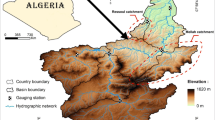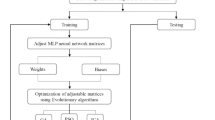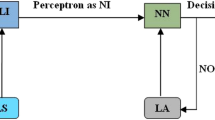Abstract
Development of cities, destruction of forests and pastures, population growth and other factors have increased suspended sediment load in rivers of developing countries. Measurement of suspended sediment load is a challenging issue for engineers at flood conditions. The case study of this research is Idenak hydrometric station on the Marun River in the south west of Iran. The used data consists of 42 years (1968 to 2009) flood discharge. A perceptron artificial neural network is trained and validated by observed data. For training of Artificial Neural Network (ANN), momentum and Levenberg-Marquardt training methods are applied. For decreasing of Normalized Mean Square Error (NMSE) and increasing of correlation coefficient (R), parameters of ANN are optimized by Genetic Algorithm (GA) method. GA method optimizes the number of nodes of hidden layers of ANN that is trained by Levenberg-Marquardt training method while it optimizes the number of nodes and momentum of ANN that is trained by momentum training method. GA method can reduce NMSE to 80% while GA method doesn’t increase R significantly. In order to predict flood condition, the Markov chain method is applied. The results show that suspended sediment load may be increased almost from 400000 ton/day to 800000 ton/day at future.
Similar content being viewed by others
References
Alp, M. and Cigizoglu, H. K. (2007). “Suspended sediment load simulation by two artificial neural network methods using hydrometeorological data.” Environmental Modelling & Software, Vol. 22, No. 1, pp. 2–13, DOI: 10.1016/j.envsoft.2005.09.009.
Chau, K. W., Wu, C. L., and Li, Y. S. (2005). “Comparison of several flood forecasting models in Yangtze River.” Journal of Hydrologic Engineering, ASCE, Vol. 10, No. 6, pp. 485–491, DOI: 10.1061/(ASCE)1084-0699(2005)10:6(485).
Cheng, C. T., Wang, W. C., Xu, D. M., and Chau, K. W. (2008). “Optimizing hydropower reservoir operation using hybrid genetic algorithm and chaos.” Water Resources Management, Vol. 22, No. 7, pp. 895–909, DOI: 10.1007/s11269-007-9200-1.
Cigizoglu, H. K. (2004). “Estimation and forecasting of daily suspended sediment data by multi-layer perceptrons.” Advances in Water Resources, Vol. 27, No. 2, pp. 185–195, DOI: 10.1016/j.advwatres.2003.10.003.
Cigizoglu, H. K. and Alp, M. (2006). “Generalized regression neural network in modelling river sediment yield.” Advances in Engineering Software, Vol. 37, No. 2, pp. 63–68, DOI: 10.1016/j.advengsoft. 2005.05.002.
Cigizoglu, H. K. and Kisi, O. (2006). “Methods to improve the neural network performance in suspended sediment estimation.” Journal of Hydrology, Vol. 317, No. 3–3, pp. 221–238, DOI: 10.1016/j.jhydrol.2005.05.019.
de Souza, C. (2010). “Neural Network Learning by the Levenberg-Marquardt Algorithm with Bayesian Regularization (part 1).” http://www.codeproject.com/Articles/55691/Neural-Network-Learning-bythe-Levenberg-Marquardt.
Hsu, P. C., Chen, C. N., and Tasi, C. T. (2011). “Real-time prediction of the peak suspended sediment concentration and sediment yield of the Lao-Nung River during storms.” International Journal of Sediment Research, Vol. 26, No. 2, pp. 163–180, DOI: 10.1016/S1001-6279(11)60084-X
Jain, S. K. (2001). “Development of integrated sediment rating curves using ANN.” Journal of Hydraulic Engineering, ASCE, Vol. 127, No. 1, pp. 30–37, DOI: 10.1061/(ASCE)0733-9429(2001)127:1(30).
Jain, S. K. (2008). “Development of integrated discharge and sediment rating relation using a compound neural network.” Journal of Hydrologic Engineering, ASCE, Vol. 13, No. 3, pp. 124–131, DOI: 10.1061/(ASCE)1084-0699(2008)13:3(124).
Kakaei Lafdani, E., Moghaddam Nia, A., and Ahmadi, A. (2013). “Daily suspended sediment load prediction using artificial neural networks and support vector machines.” Journal of Hydrology, Vol. 478, pp. 50–62, DOI: 10.1016/j.jhydrol.2012.11.048.
Kumar, A. R. S., Ojha, C. S. P., Goyal, M. K., Singh, R. D., and Swamee, P. K. (2012). “Modelling of suspended sediment concentration at Kasol in India using ANN, fuzzy logic and decision tree algorithms.” Journal of Hydrologic Engineering, ASCE, Vol. 17, No. 3, pp. 394–404, DOI: 10.1061/(ASCE)HE.1943-5584.0000445.
Makarynskyy, O., Makarynska, D., Rayson, M., and Langtry, S. (2015). “Combining deterministic modelling with artificial neural networks for suspended sediment estimates.” Applied Soft Computing, Vol. 35, pp. 247–256, DOI: 10.1016/j.asoc.2015.05.044.
Melesse, A. M., Ahmad, S., McClain, M. E., Wang, X., and Lim, Y. H. (2011). “Suspended sediment load prediction of river systems: An artificial neural network approach.” Agricultural Water Management, Vol. 98, No. 5, pp. 855–866, DOI: 10.1016/j.agwat.2010.12.012.
Muttil, N. and Chau, K. W. (2006). “Neural network and genetic programming for modeling coastal algal blooms.” International Journal of Environment and Pollution, Vol. 28, No. 3–3, pp. 223–238, DOI: 10.1504/IJEP.2006.011208.
Nagy, H. M., Watanabe, K., and Hirano, M. (2002). “Prediction of sediment load concentration in rivers using artificial neural network model.” Journal of Hydraulic Engineering, ASCE, Vol. 128, No. 6, pp. 588–595, DOI: 10.1061/(ASCE)0733-9429(2002)128:6(588).
Partal, T. and Cigizoglu, H. K. (2008). “Estimation and forecasting of daily suspended sediment data using wavelet-neural networks.” Journal of Hydrology, Vol. 358, No. 3–3, pp. 317–331, DOI: 10.1016/j.jhydrol.2008.06.013.
Raghuwanshi, N. S., Singh, R., and Reddy, L. S. (2006). “Runoff and sediment yield modeling using artificial neural networks: Upper Siwane River, India.” Journal of Hydrologic Engineering, ASCE, Vol. 11, No. 1, pp. 71–79, DOI: 10.1061/(ASCE)1084-0699(2006)11:1(71).
Rajaee, T. (2011). “Wavelet and ANN combination model for prediction of daily suspended sediment load in rivers.” Science of The Total Environment, Vol. 409, No. 15, pp. 2917–2928, DOI: 10.1016/j.scitotenv.2010.11.028.
Rajaee, T., Mirbagheri, S. A., Zounemat-Kermani, M., and Nourani, V. (2009). “Daily suspended sediment concentration simulation using ANN and neuro-fuzzy models.” Science of The Total Environment, Vol. 407, No. 17, pp. 4916–4927, DOI: 10.1016/j.scitotenv.2009.05.016.
Rajaee, T., Nourani, V., Zounemat-Kermani, M., and Kisi, O. (2011). “River suspended sediment load prediction: application of ANN and wavelet conjunction model.” Journal of Hydrologic Engineering, ASCE, Vol. 16, No. 8, pp. 613–627, DOI: 10.1061/(ASCE)HE.1943-5584.0000347.
Xu, Z. X., Schumann, A., and Brass, C. (2001). “Markov autocorrelation pulse model for two sites daily streamflow.” Journal of Hydrologic Engineering, ASCE, Vol. 6, No. 3, pp. 189–195, DOI: 10.1061/(ASCE)1084-0699(2001)6:3(189).
Xu, Z. X., Schumann, A., and Li, J. (2003). “Markov cross-correlation pulse model for daily streamflow generation at multiple sites.” Advances in Water Resources, Vol. 26, No. 3, pp. 325–335, DOI: 10.1016/S0309-1708(02)00172-0.
Zhu, Y. M., Lu, X. X., and Zhou, Y. (2007). “Suspended sediment flux modeling with artificial neural network: An example of the Longchuanjiang River in the Upper Yangtze Catchment, China.” Geomorphology, Vol. 84, No. 1–3, pp. 111–125, DOI: 10.1016/j.geomorph.2006.07.010.
Author information
Authors and Affiliations
Corresponding author
Rights and permissions
About this article
Cite this article
Adib, A., Mahmoodi, A. Prediction of suspended sediment load using ANN GA conjunction model with Markov chain approach at flood conditions. KSCE J Civ Eng 21, 447–457 (2017). https://doi.org/10.1007/s12205-016-0444-2
Received:
Revised:
Accepted:
Published:
Issue Date:
DOI: https://doi.org/10.1007/s12205-016-0444-2




